Our Embiggen Druid deck list guide for the Descent of Dragons expansion features one of the top lists for this archetype. This Druid guide includes Mulligan Strategy, Gameplay Tips, Card Substitutions, and Combos/Synergies!
Introduction
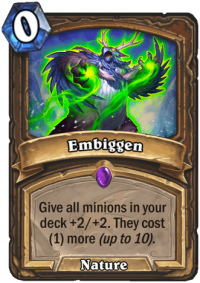
The potential of Embiggen was clear from the moment it was revealed as one of the cards from the Descent of Dragons set, but it only realized its true potential now after a bunch of Galakrond nerfs and some key additions in the form of Winged Guardian, a monstrously overstatted card from the new adventure that is perfect for any strategy with reliable ramp options. It’s Prince Keleseth on steroids, and Druid’s Dragon synergies coupled with the ramp potential of Breath of Dreams enables some incredible swings with the deck. It’s the sort of straightforward tempo deck which has long been missing from Hearthstone’s metagame, so if you enjoyed playing with Odd Rogue or the aggressive Dragon Warrior from Whispers of the Old Gods, you’ll likely find that Embiggen Druid is right up your alley.
The archetype still has multiple viable lists with slightly different approaches (we’ll list those in the Card Replacements section). The featured build opts for the simplest possible tempo strategy for the highest possible return on consistency.
Embiggen Druid Deck List
Check out alternative versions of this deck on our Embiggen Druid archetype page!
Mulligan Guide and Strategy
Higher Priority (Keep every time)
- Embiggen – There’s a reason this deck is named after the eponymous card:
- Breath of Dreams – This is Wild Growth on steroids, and something you want to play as soon as possible. Even if you don’t have a Dragon in your opening hand, you need to hold on to this one.
- Strength in Numbers – Playing this on turn one all but guarantees an extra minion on your side of the board by turn six, which can be a crucial bit of added tempo, especially if you miss out on the other two premium cards listed above.
Lower Priority (Keep only if certain conditions are met)
- Frizz Kindleroost – If you can ramp to it with Breath of Dreams or can set up an early Sidequest completion with a 2-drop and the Coin alongside it, it’s worth keeping in your opening hand. However, this effect isn’t impactful enough by itself to keep it without your premium tools.
- Keep a Dragon with Breath of Dreams, but toss back all of them otherwise.
General Playstyle and Strategy
Vs Aggro
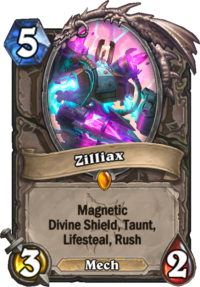
Since you only have one heal card in the deck in the form of Zilliax, your strategy has to revolve around setting up a wall of Taunts. Mucking around with Scaleriders and the few other low-cost minions in your deck will get you nowhere fast. (Perhaps it goes without saying, but do not hold back Embiggen for curve considerations.) You must play to your strengths, which is playing big stat stick after big stat stick until your opponent cannot ignore them anymore. Ideally, you want to get to 6-7 mana as soon as possible so that you can play Emerald Explorer and Winged Guardian, which are usually enough to stop any aggression.
From then on, make sure to go in for the kill as quickly as possible: your overstatted minions will easily set up a two-turn kill in most scenarios, and if you managed to establish a board with multiple Taunts, the only way you can throw the game is by giving your opponent enough time to draw their burn spells. That said, these are the more challenging matchups for your deck, and there are some tech options listed below which can help into run into a pocket of the meta full of SMOrc aficionados.
Vs Control
This is the fun stuff. Sometimes, you’ll score blowout victories by placing three mid-size threats on the board and never looking back. Those games don’t require much of a guide to figure out. So how about the rest of it? It’s all about segmenting your threats in the most efficient way possible and mathing out your turns carefully. (We’ll cover the ins and outs of Strength in Numbers in the next section of this guide.) At the time of writing, not many of the top meta decks can deal with a board of multiple minions that have 5+ health, with perhaps the notable exception of Resurrect Priest. The basic approach is the same: prioritize ramp over short-term tempo plays, play low-initiative minions whenever possible instead of wasting Rush abilities when they are not necessary, and don’t overcommit on the board. Two “embiggened” minions left unchecked will already pose a two-turn clock, forcing a hard removal out of your opponent. If you can consistently force them to make inefficient clears without ever gaining tempo, they will run out of answers before you exhaust your threats. Keep in mind that you’re aggressor with the big minions: go face as often as possible.
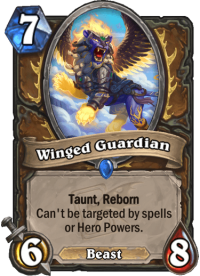
A few notes about the Priest matchup: the game doesn’t really begin until turn five. You don’t want to deal early damage to them, and they won’t be able to attack you or meaningfully develop anything. By that point, you will have a good idea of your gameplan based on whether you had added ramp and/or buff tools available. Their only AoE at that point is Mass Hysteria, meaning two decent-sized threats can often push through their early resistance.
Otherwise, you can play it very slow, denying them Quest completion as long as possible. Their minions will not trade favorably with yours at any point in the match (with the notable exception of a buffed Batterhead), and you have enough Rush cards to potentially go the control route against them, especially if you get strong value cards from Emerald Explorer. Both are viable strategies and are mainly governed by your draw. Also, play Leeroy Jenkins as early as possible to ruin their resurrection pool. Discovering cards like Marsh Drake is also extra beneficial in this matchup.
Mirror match
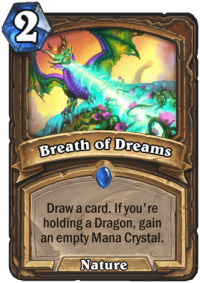
Though the Druid-versus-Druid matchups may initially seem like one of those “who manages to skillfully draw Wild Growth on two” sort of affairs from the past, the presence of three different strong stat/mana boosting tools in the deck (as outlined in the mulligan guide) creates a lot of different gameplay situations where your role as the control or the beatdown player changes according to these early draws. You’ll often encounter a situation where one player has Breath of Dreams and the other has Embiggen in their opening hand. If you’re the one with the mana advantage, you need to play control, and vice versa. Strength in Numbers provides a non-negligible tempo benefit in otherwise even circumstances but doesn’t make up for the other two by itself.
Just like against Control decks, you want to prioritize low-initiative minions wherever possible. (Think about it this way: if choose to play the Evasive Wyrm instead of the Emerald Explorer, the latter will take two more turns to attack. Otherwise, they can both attack on the following turn.) Since the untargetable effect knocks out Swipe, a careful analysis of health break points can also force your opponent into making inefficient trades. For most of the game, this matchup is strictly about board control – but there comes a certain moment when you can set up a two-turn lethal and develop behind your existing threats, at which point you should certainly consider doing so.
Gameplay Tips & Tricks
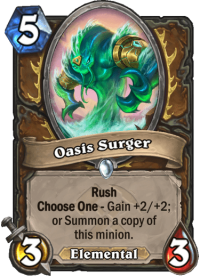
- Strength in Numbers math: with the Coin, you should be able to find a way to finish the Sidequest by turn five. Either 2+3+5, 2+4+4, 5+5 or 4+6 will get you there, and you should be willing to make small tempo concessions to get it done as soon as possible. (Don’t prioritize it over a Breath of Dreams though!)
- Just like in Arena, your baseline approach should be to play your biggest curve card every turn. Playing a 5-drop instead of a 3 and a 2 when you have five mana makes it more likely that you can fully utilize your resources in further turns as well. Unused mana adds up quickly in this game!
- You might instinctively go for the 5/5 version of Oasis Surger whenever possible, but keep in mind that the split version will produce more total stats even for the vanilla iteration of the card.
Card Replacements
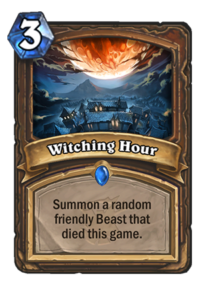
There are multiple alternative Embiggen Druid builds doing the rounds right now, with an emphasis on a different anti-aggro approach. The question is this: how much consistency do you want to sacrifice for highroll potential? You can incorporate one or two copies of Witching Hour to go nuts with extra Winged Guardians, perhaps also sprinkle in a Witchwood Grizzly or two to improve your odds against fast decks. Maybe even an Archmage Vargoth, who works well with all but one spell in the deck but is a useless vanilla drop in standard gameplay scenarios. Maybe you want to crush the mirror, like Platypus did with his #93 Legend deck (which you can find below) and add two copies of Dragonmaw Poacher and a Savage Roar alongside a Spellbreaker. There is a lot of flexibility with the archetype, and even if you’re missing certain core cards, you will almost surely be able to put together a workable version.
In our test run of 65 games from rank 3 to middling Legend ranks, Druids and Hunters made up half of the field (a circa 3:2 ratio). Whether that’s enough to aggressively tech for is a question of taste in many ways. The featured build will never run into situations where you are stuck with unplayable cards in your hands – but the strength and flexibility of the archetype leaves a lot of room for adjustment based on personal preference.
Leave a Reply
You must be logged in to post a comment.

This is My updated deck for Ashes Of OutLand!
### Embiggen Druid
# Class: Druid
# Format: Standard
# Year of the Phoenix
#
# 2x (0) Embiggen
# 2x (1) Strength in Numbers
# 2x (2) Breath of Dreams
# 2x (2) Wrath
# 2x (3) Bogbeam
# 2x (3) Overconfident Orc
# 1x (4) Frizz Kindleroost
# 2x (4) Overgrowth
# 2x (5) Big Ol’ Whelp
# 2x (5) Oasis Surger
# 2x (6) Emerald Explorer
# 2x (6) Evasive Wyrm
# 1x (7) Overflow
# 2x (7) Winged Guardian
# 1x (9) Alexstrasza
# 1x (9) Ysera, Unleashed
# 2x (10) Scrapyard Colossus
#
AAECAaa4AwTFBNulA/atA4iwAw3EBtmpA/utA/2tA4yuA96vA+ewA4WxA/+1A+i6A+66A/O7A+a+AwA=
#
# To use this deck, copy it to your clipboard and create a new deck in Hearthstone
Is it worth running Ysera Unleashed for some late game fuel against control decks?
Do you ever not play Embiggen when you have it?
Lots of times actually…
Vs face hunter i never plays it, even if i dont have anything else to do, because you need more the 1 mana more thant the stats.
I play Vargoth, so if i get both i wait till turn 4 to copy it.
Vs pretty much else i sometimes wait if i dont have turn 2-5 plays, and play it in turn 4 because its better to have something to play in those turns and abuse its effect later, plus sometimes you get the Vargoth in the meantime.
Is winged guardian necessary? Maybe an evasive drakonoid is good enough?
Evasive Drakonid is an okay replacement, but Winged Guardian is much better.
Total stats are the same, although I’d argue that 6/8 is a slightly better distribution. Tribes are also similar – Dragon tag is an upside when it comes to Breath of Dreams / Scalerider / Frizz (if you run it of course), but then the Beast tag is an upside because of Witching Hour and Dragonmaw Poacher (which is getting more and more popular as a tech card). But Winged Guardian has extra Reborn, which makes a big difference. Opponents often need to run another mid-sized minion into it to kill it or sometimes even drop an AoE, since they can’t single target remove it because of Elusive. It also makes your board more resistant to AoE clears – e.g. after Warlock drops Twisting Nether, you will still have a 6/1 up. That Reborn part alone has won me a bunch of games.
Long story short – if you just want to test out the deck, you can use Evasive Drakonid and it will be okay. But if you want to run the deck seriously, I’d recommend buying Chapter 1.
Its absolutely necessary, I would actually says its the more important card in the deck, the glue that fix everything and made this deck playable…
I kind of disagree – the deck was already playable earlier, Winged Guardian just made players experiment with the deck more and find optimal builds + realize that. I played Embiggen Druid before Galakrond’s Awakening and it was already pretty solid. Of course, Winged Guardian made it better, but it’s definitely not one of the most important cards in the deck.
At any given meta, there are probably a few good decks that haven’t been discovered (or only see off-meta play because general playerbase doesn’t realize how good they are).
I completely agree with that assessment. Embiggen druid was quite strong already and I have been saying that for quite few weeks. I was successfully playing the deck quite a lot before it became mainstream. Heck I even climbed to legend with it before Galakronds awakening. Lately however, I played maybe 2 or 3 games because I am always the kind of player who tries to counter the meta and not join the netdecking crowds.
The decklists (on HSreplay for instance) where just wrong. Vicious scalehide for instance has no business in a tempo deck like this. There is no denial that Winged Guardian is a very good card and fits perfectly to the deck (my estimate is that it improves winrate for up to 0,5%). It is however by no means deck defining or even mandatory card.
For the record, I believe some other decks are underestimated by the community as well.